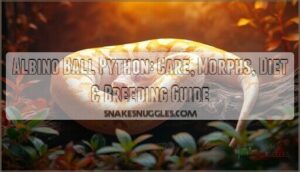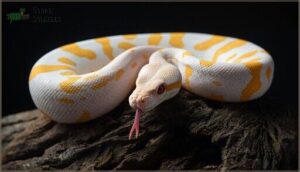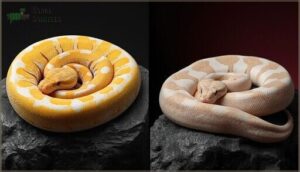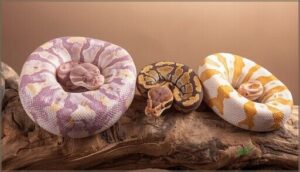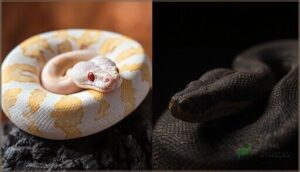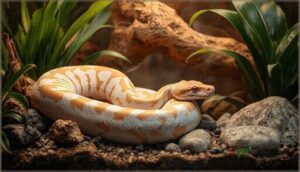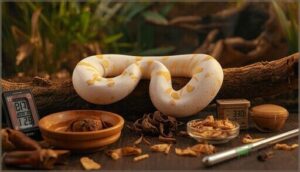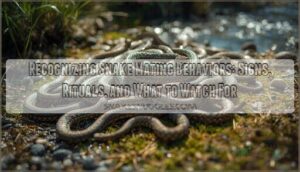This site is supported by our readers. We may earn a commission, at no cost to you, if you purchase through links.
The first time you see an albino ball python under proper lighting, the effect borders on surreal. What should be earthy brown transforms into luminous yellow against bone-white skin, while pink eyes track movement with surprising precision. This isn’t a digital filter or careful Photoshop work—it’s the result of a simple genetic switch that eliminates melanin entirely.
Since captive breeders first produced these snakes in the early 1990s, albino ball pythons have become cornerstones of the designer morph market, yet their care requirements remain identical to their wild-type cousins. The real challenge isn’t maintaining their striking appearance, but understanding how that signature coloration affects everything from light sensitivity to thermoregulation in your setup.
Table Of Contents
- Key Takeaways
- What is an Albino Ball Python?
- Albino Ball Python Appearance and Morphs
- Albino Ball Python Care and Housing
- Diet, Health, and Behavior
- Breeding, Price, and Availability
- Frequently Asked Questions (FAQs)
- How much does an albino ball python cost?
- How rare are albino pythons?
- What is the lifespan of an albino ball python?
- Do albino snakes have health issues?
- How long do albino ball pythons typically live?
- Can albino ball pythons breed with other morphs?
- Do albino ball pythons have special veterinary needs?
- What size tank do baby albinos need?
- Are albino ball pythons more aggressive than normal?
- Do albino ball pythons need special lighting?
- Conclusion
Key Takeaways
- Albino ball pythons lack melanin entirely due to a recessive gene mutation, resulting in their signature yellow-on-white coloration and pink eyes, but they require identical care to wild-type ball pythons with one critical exception—reduced lighting intensity to accommodate their heightened photosensitivity.
- Proper husbandry centers on maintaining precise environmental parameters: 80-85°F ambient temperature with a 90-95°F basking spot, 50-60% humidity (spiking to 70-80% during shed cycles), and enclosures measuring at least 4’x2’x2′ for adults with dual hides and appropriate substrate.
- The albino morph’s market value has plummeted from $7,500 in 1992 to $150-250 today due to widespread captive breeding, though designer combinations like Lavender Albino Pied still command $600-2,250 based on genetic complexity and visual contrast retention.
- These snakes display no increased aggression compared to normal morphs and can live 20-30 years in captivity, but their amelanistic condition increases susceptibility to UV damage, eye problems, and skin issues—making annual reptile veterinary exams essential for long-term health.
What is an Albino Ball Python?
An albino ball python is a striking color morph of the ball python species (Python regius), native to the grasslands and forests of West and Central Africa. These snakes lack melanin—the pigment responsible for dark coloration—resulting in their signature bright yellow patterns against a white or cream background, paired with light-sensitive pink or red eyes.
First bred in captivity in the early 1990s, albino ball pythons quickly became one of the most recognizable and sought-after morphs in the reptile trade.
Origins and Natural Habitat
Ball pythons trace their African roots to the grasslands and savannas of West Africa—spanning from Senegal to Uganda. In the wild, they inhabit sparsely wooded terrain near water sources, burrowing underground to escape temperature extremes.
Understanding their savannah ecology and climate adaptation helps you replicate a proper habitat setup, ensuring your albino ball python thrives under ideal reptile care conditions year-round. To maintain ideal health, it’s essential to monitor and control the temperature requirements in their enclosure.
Distinctive Physical Characteristics
What really sets the albino morph apart is its complete lack of melanin—so instead of typical browns, you’ll see creamy white skin pigmentation with bold yellow patterns. Their red or pink eye color is unmistakable, a direct result of absent ocular melanin.
Scale texture stays smooth and glossy, while body size mirrors wild-types at three to five feet. Pattern variability ranges from high-contrast yellow blotches to softer, blended markings depending on lineage.
The genetic diversity of albino ball pythons is influenced by albino morph combinations.
Albino Ball Python Appearance and Morphs
Albino ball pythons stand out with their striking yellow and white coloration—a complete departure from the earthy browns of their wild-type cousins. But not all albinos look the same, and understanding the variations can help you appreciate what makes each snake unique.
Let’s break down the classic coloration, contrast differences, popular designer combinations, and the genetics behind it all.
Classic Albino Coloration and Patterns
When you look at a classic albino ball python, you’ll notice the complete absence of melanin production creates a striking white base overlaid with vivid yellow “alien head” blotches—the same pattern structure seen in wild-type ball pythons, just radically transformed.
Their red eyes and pink tongue reveal the depth of this amelanistic condition, while scale structure remains completely unaffected by the TYR gene mutation.
High Contrast Vs. Low Contrast Albinos
Within the albino morph, you’ll see striking genetic variation that divides these snakes into two distinct groups based on visual appeal. High contrast albinos maintain sharply defined white-and-yellow patterns into adulthood—around 70% keep that crisp separation. Low contrast specimens fade toward pale, washed-out tones, with 60% losing clarity by year two.
This distinction matters for breeding strategies and color morphs you’re planning, since:
- High contrast albino ball pythons command 15–25% higher prices
- Mixed pairings yield only 45% high contrast offspring
- Three generations of selective breeding stabilize contrast inheritance
Popular Designer Morphs (e.g., Lavender, Pied, Enchi)
Designer morphs transform the classic albino into living art. Lavender genetics create soft purple hues with yellow patterns—double-recessive combinations that usually run $400–$800. Pied patterns add dramatic white patches, while Enchi influence intensifies gold tones and reduces dorsal markings. These breeding strategies demand patience, since only 25% of double-recessive pairings yield visual results.
| Morph Combination | Typical Price Range |
|---|---|
| Lavender Albino | $400–$800 |
| Albino Pied | $600–$1,400 |
| Lavender Albino Pied (Dreamsicle) | $600–$2,250 |
| Enchi Albino | $350–$600 |
| Multi-gene Lavender Projects | $1,400–$4,500 |
How Albinism Affects Pigmentation
Melanin production in albino ball pythons halts completely due to nonfunctional tyrosinase—the enzyme that converts tyrosine into pigment. You’ll notice pure yellows and whites replacing the wild-type’s brown saddles because carotenoid pigments survive while melanin disappears.
That tyrosinase gene disruption creates the signature pink eyes and light-sensitive retinas, linking skin patterns directly to ocular traits in this recessive morph.
Albino Ball Python Care and Housing
Getting the setup right is where many new keepers stumble, but it doesn’t have to be complicated. Your albino ball python needs specific conditions to stay healthy—think of it as building a climate-controlled studio apartment for a snake with light-sensitive eyes.
Let’s break down the essentials so you can create a space where your python will actually thrive.
Recommended Enclosure Size and Setup
Your albino ball python’s enclosure is basically its entire world—getting the habitat design right matters. Adults need at least 4 feet x 2 feet x 2 feet (roughly 65-75 gallons), while hatchlings can start in 10-gallon tanks.
Prioritize PVC enclosures for excellent humidity control and heat retention, paired with secure lids to prevent escapes. Include two hides, climbing branches, and a water dish large enough for soaking.
Temperature and Lighting Requirements
Think of temperature regulation as the heartbeat of your snake’s health—without proper thermal gradients and lighting systems, even the most stunning albino morph won’t thrive.
Here’s what you need:
- Ambient temperatures: 80-85°F daytime, dropping to 70-78°F at night
- Basking spot: 90-95°F using ceramic heat emitters or radiant panels
- Cool zone: 76-80°F for thermoregulation
- UVB exposure: 2-2.5% intensity bulbs for 10-12 hours daily
- Temperature control: Digital thermostats prevent dangerous overheating
Their photosensitive pink eyes demand careful lighting and illumination choices.
Humidity and Water Needs
Maintaining proper moisture control isn’t optional—it’s the difference between a healthy shed and a veterinary emergency. You’ll need to balance ambient humidity levels between 50–60% routinely, spiking to 70–80% during visible pre-shed phases.
| Parameter | Routine | Shedding |
|---|---|---|
| Humidity Levels | 50–60% | 70–80% |
| Water Quality | Fresh daily | Fresh daily |
| Evaporation Rates | Monitor digitally | Increase misting |
Position your water bowl on the warm side to boost humidity through natural evaporation rates while supporting hydration methods. Digital hygrometers beat analog devices for accurate moisture control—and your albino’s photosensitive eyes will thank you for the stability.
Safe Substrates and Habitat Decor
Your enclosure design starts from the ground up—literally. Substrate options and decor essentials work together to maintain humidity control while supporting natural behaviors in your albino ball python.
Top substrate choices for ideal habitat setup and design:
- Coconut husk – Maintains humidity levels without excessive dust
- Aspen shavings – Absorbs waste while encouraging burrowing
- Cypress mulch – Holds moisture when properly sourced
- Paper towels – Perfect for quarantine or medical care
- Avoid pine/cedar – Toxic oils cause respiratory distress
Install at least two snug-fitting hides (one per temperature zone) to reduce stress. Bioactive systems incorporating live plants and organic substrate promote healthy humidity while mimicking natural environments—that’s expert reptile care and maintenance worth considering.
Diet, Health, and Behavior
Keeping your albino ball python healthy goes beyond setting up the perfect tank. You’ll need to understand their feeding habits, watch for common health problems, and learn how they communicate stress or comfort.
Let’s walk through what your snake needs to thrive day-to-day.
Feeding Schedule and Prey Options
You’ll want to offer frozen-thawed rodents once every 5–7 days for hatchlings, shifting to weekly feeding for juveniles under 200 g. As your snake grows, extend meal planning to every 7–14 days based on weight—prey size should represent 10–15% of body mass. This feeding frequency promotes nutrient balance while preventing obesity.
Rats provide better food variety than mice alone, and these feeding strategies maintain ideal diet and nutrition throughout life.
Common Health Issues and Prevention
Even with proper feeding, your albino can face respiratory care challenges—infections strike up to 25% of ball pythons when temperatures drop below 88°F. Watch for wheezing or mouth discharge.
Shedding tips matter too: humidity below 50% causes incomplete sheds in over 70% of cases.
Parasite control, skin infections, and obesity all demand health monitoring. These health issues need swift nutrition advice and habitat adjustments for ideal reptile health and disease prevention.
Handling, Socialization, and Behavior Traits
Beyond health concerns, your albino thrives on gentle interaction—but timing matters. Wait two weeks after bringing yours home before handling begins. Snake handling tips show defensive mechanisms fade when you limit sessions to 10–15 minutes, 2–3 times weekly.
Social behavior isn’t what you’d expect: juveniles actually seek contact with other pythons. Acclimation techniques and stress reduction methods build trust fast.
- Support two-thirds of the body during handling
- Avoid quick movements that trigger defensive responses
- Keep sessions under 15 minutes for stress reduction
- Handle consistently from juvenile stage for best results
- Watch for coiling behavior—it signals overwhelm, not aggression
Signs of Stress in Albino Ball Pythons
Recognizing stress indicators early protects your python from cascading health complications. Watch for persistent pacing—over 35% of stressed individuals rub enclosure walls constantly. Sudden appetite loss lasting two weeks signals deeper issues.
Environmental factors like harsh lighting or missing hides trigger defensive strikes in 25% of cases.
Irregular breathing, incomplete sheds, or nose rubbing demand immediate husbandry adjustments—these behavioral changes aren’t just temperament.
Breeding, Price, and Availability
Albino ball pythons have come a long way since Bob Clark introduced the first captive-bred specimens to the market in 1992.
Today, understanding how the albino gene passes from parent to offspring helps you make informed breeding decisions and recognize what you’re paying for.
Whether you’re looking to breed your own or purchase one, knowing the market landscape and where to find healthy specimens makes all the difference.
History of Albino Ball Python Breeding
In 1992, breeder Bob Clark revolutionized reptile breeding by producing the first captive-bred albino ball python—a breakthrough that transformed ball pythons from inexpensive imports into coveted collector pieces. Those early albino morphs sold for around $7,500 each, launching decades of genetic research and morph development.
Bob Clark’s 1992 captive-bred albino ball python—selling for $7,500—transformed the species from cheap imports into prized collector pieces
By the early 2000s, breeders had introduced variations like the Lavender Albino, expanding designer snake breeding despite ongoing conservation efforts addressing wild-caught trade concerns.
Inheritance of The Albino Gene
You’ll need both parents to carry the recessive albino gene for your snake to display those stunning yellow-and-white patterns. Genetic testing and molecular genetics now allow breeders to identify hidden carriers through allele identification, transforming reptile genetics guesswork into science.
Understanding these inheritance patterns enables you to:
- Predict offspring outcomes before pairing your breeding snakes
- Identify het albino carriers that look normal but carry the gene
- Create designer morphs by combining the albino morph with other traits
- Avoid wasted pairings through targeted gene expression analysis
When you cross two het albinos, you’ll get 25% albino ball pythons, 50% carriers, and 25% normals—classic snake genetics ratios that every breeder should master.
Market Trends and Pricing Factors
Since Bob Clark dropped the first captive-bred albinos into the market back in 1992, price fluctuation has been dramatic—where breeders once commanded $3,000 for adult females, today’s supply chain flooded with over 32,000 listings means you’ll find standard albinos around $150–$250.
Breeding costs, demand trends, and genetic complexity still drive designer morphs higher, while reptile sales data shows common morphs hit hardest by oversaturation.
Where to Buy Albino Ball Pythons
You’ve got solid options for buying pet snakes, but choosing the right source makes all the difference for your albino’s health and genetics.
When buying ball pythons online, consider:
- Online breeders offering documented genetics and feeding records for captive-bred snake morphs
- MorphMarket and reptile auctions filtering 30,000+ listings by morph, price, and seller ratings
- Reptile expos where 80% of snakes are ball pythons—perfect for hands-on inspection
- Pet store chains at $400, though specialized sellers list healthy albinos around $150
- Professional facilities guaranteeing live arrival and species documentation per shipping regulations
Reptile breeding and sales through established vendors reduce risk in reptile sales and shipping.
Frequently Asked Questions (FAQs)
How much does an albino ball python cost?
You’ll find most albino ball pythons priced between $199 and $350 in 2025, though designer morphs like Albino Pied can reach $300 or more depending on genetics and breeder reputation.
How rare are albino pythons?
Albino pythons are extremely rare in nature, occurring in less than 1 in 10,000 wild individuals. Captive breeding has made them common in the pet trade, shifting population dynamics from scarcity to widespread availability.
What is the lifespan of an albino ball python?
Despite their delicate appearance, these pale beauties aren’t fragile at all—your albino ball python can easily live 20 to 30 years in captivity with proper care, outlasting most dogs.
Do albino snakes have health issues?
Yes—reduced melanin increases UV sensitivity, raising risks of skin cancer and ocular damage. Visual impairments like photophobia are common. Albino ball pythons face these genetic disorders but thrive with proper lighting and care adjustments.
How long do albino ball pythons typically live?
Many assume snakes are short-lived, but with proper snake care and reptile health practices, your ball pythons can thrive for 20 to 30 years.
Factors like stable temperatures and routine veterinary visits directly influence longevity records and mortality rates.
Can albino ball pythons breed with other morphs?
You can pair your albino ball python with virtually any compatible morph—recessive, codominant, or dominant—because genetic compatibility isn’t restricted, making designer albino hybrids possible through strategic breeding outcomes.
Do albino ball pythons have special veterinary needs?
Albino ball pythons require heightened veterinary care due to increased skin issues, light-sensitive eye problems, and susceptibility to mouth rot and respiratory infections. Annual exams with a reptile veterinarian help catch health risks early.
What size tank do baby albinos need?
A 10-gallon tank (20″ × 11″ × 13″) provides proper enclosure setup for hatchlings under six months.
Tank size guidelines recommend secure ventilation systems, humidity control between 50–60%, and dual hides supporting baby snake care requirements during early development.
Are albino ball pythons more aggressive than normal?
Despite their striking appearance, these snakes show no heightened aggression compared to wild-type individuals.
Defensive behavior stems from stress management issues—poor handling techniques, inadequate hiding spots, or environmental factors—not genetic coloration differences.
Do albino ball pythons need special lighting?
You won’t need UV lighting for your snake, though a simple day-night cycle helps with natural rhythms.
Light sensitivity in albinos means avoiding bright, direct exposure—gentle ambient light works best.
Conclusion
That pink-eyed gaze symbolizes more than genetic novelty—it represents a responsibility to honor biology while celebrating aesthetic innovation. Whether you’re drawn to classic amelanistic beauty or complex designer combinations, success hinges on consistent environmental parameters and attentive observation. These snakes don’t demand exceptional measures, just informed ones.
Your albino ball python thrives when you respect its heightened light sensitivity alongside standard husbandry protocols. Master the fundamentals, and that luminous yellow-and-white pattern becomes a daily reminder of captive breeding done right.

